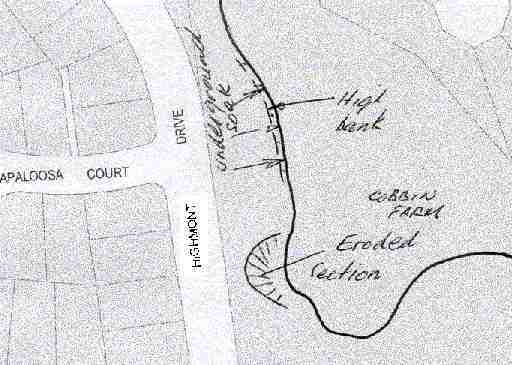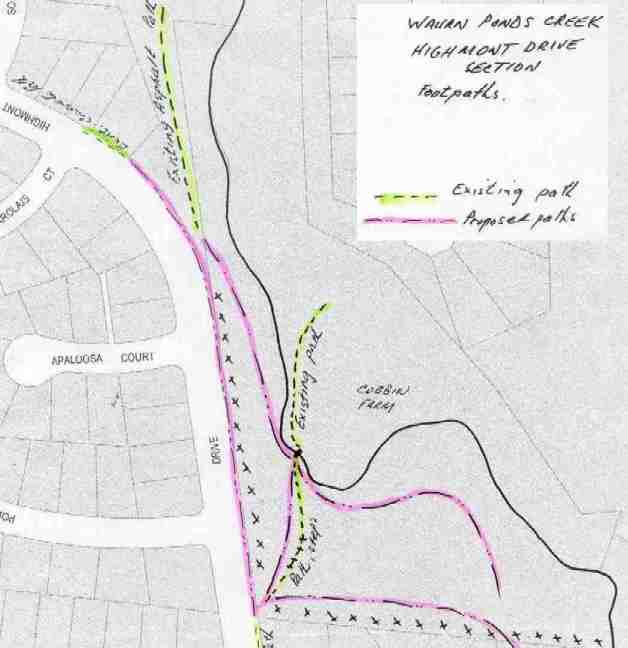| Home | What we do | What's on | Yarra Pygmy Perch | Our History | FAQ | Resources | Things to see | Photo Gallery | Contact Us |
|---|

The section of Waurn Ponds Creek reserve under consideration is the north bank adjacent to Highmont Drive, across the creek from Cobbin Farm. It extends from the rear of properties fronting Pinetree Court east for about 300m, i.e. to a point midway between and opposite, Apaloosa and Charolais Courts.
The creek bank is steep, overgrown with exotic trees, shrubs and creepers, and in one place seriously eroded. There is one footpath running diagonally across the west end of the bank from Highmont Drive to the existing path at Cobbin Farm.
The purpose of this report is to make recommendations on rehabilitation and revegetation of this small but complex section of Waurn Ponds Creek.
Highmont Drive runs east from Waurnvale Drive for about 300m before curving in a north-easterly direction.
Housing exists on the south side for about 100m, then there is a section of creek reserve for 250m before housing recommences.
The road edge is only about 30m from the creek at the nearest point, but it is perhaps 20m above it.
When Highmont Drive was constructed, a line of Australian trees - principally Eucalypt and Acacia species but none locally indigenous - was planted along the top of the bank, adjacent to the road reserve.
Between these trees and the creek is a mix of exotic plants, notably Silver Poplar and Desert Ash, with a dense cover of English Ivy and some other creepers. There are also Agapanthus, Pampus Grass and other shrubs.
These were probably part of the Cobbin Farm gardens but are now neglected and overgrown with extensive suckering of the poplars.
The footpath that runs beside the creek, and crosses it, at Cobbin Farm was extended diagonally up the side of the embankment to meet the existing concrete footpath in Highmont Drive. It is rather steep, and several wooden steps, and a seat, have been put in on the steepest section, but these have now been bypassed perhaps because cyclists were disadvantaged by the steps.
There is a seriously eroded section of creek bank mid-way between, and opposite, Polwarth Drive and Apaloosa Court. It does not appear to be caused by water erosion from Highmont Drive which has continuous concrete kerbing, but possibly by the land slipping through a lack of trees to stabilise it. It has been made worse by human activity, probably children sliding down on pieces of sheeting. In places it has been worn down to bedrock.

Along the foot of the bank, immediately above the creek, is water seepage. This does not appear to have affected the stability of the bank, nor does it appear to be the result of suburban drainage. It may be a natural spring, or soak, that brings groundwater between the surface soil and bedrock, and it contributes to the flow in Waurn Ponds Creek. There are probably other similar springs or soaks further upstream since there is a small but steady flow in the creek, even in late summer after a period of dry weather.
This relatively short section of Waum Ponds Creek is in need of extensive restoration by -
There are several possible solutions varying from a hard treatment such as crib-walling, stone-beaching, benching or installing other mechanical devices to hold the bank in place, to simply replanting the slope with trees.
Since there seems to be a human element exacerbating the problem, control of access is another issue to be considered.
The suggestion put forward here is -
Obviously the removal of the existing exotic vegetation will need to be undertaken with care to eliminate future erosion problems.
Priority in removal should be -
Replanting should be undertaken as soon as the weeds are removed. A list of suitable species is attached.
River Red Gums and other riparian species should be planted along the creek, while woodland species are suitable for the upper slopes.
It is obvious that some access should be provided from Highmont Drive to the creek environs, but because of the steep nature of the land, care needs to be exercised during construction. The main linkage should be from near the existing creek-crossing diagonally north-west. Because many people now cycle along the creek valley, steps are not appropriate.

There should also be a path beside the row of pines behind Pinetree Court for access from the west.
At a later stage, if it becomes desirable to do so, another path may be built from the end of the existing asphalt path behind Southdown Crescent across the face of the slope to below Pinetree Court. This would complete a path along the north side of the creek, however it may also create erosion problems, so siting and construction should be undertaken carefully.
It is also desirable that a footpath be constructed behind the kerb and channel in Highmont Drive, to connect the sections of concrete footpath existing in front of the houses. This would also connect with the paths that come from beside the creek.
Drainage from the housing estate north of Highmont Drive requires inspection to ensure an appropriate outlet structure is in place at the creek.
Silt and litter traps should be installed and regularly maintained.
This section of Waurn Ponds Creek reserve, although of only a short length, has several serious problems that need careful attention.
It is also one of high visual impact because of its proximity to Cobbin Farm.
Work should begin as soon as possible.
| Scientific name | Common name | Growth | Spacing | Zone |
|---|---|---|---|---|
|
Acacia acinacea Acacia dealbata Acacia implexa Acacia meansii Acacia melanoxylon Acacia paradoxa Acacia pycnantha Acacia verticillata Allocasuarina verticillata Atriplex semibaccata Banksia marginata Bursaria spinosa Callistemon paludosa Chrysocephalum apiculatum Clematis microphylla Coprosma quadrafida Dianella revoluta Dodonea viscosa ssp cuneata Eleocharis spacelata Eucalyptus camaldulensis Eucalyptus leucoxylon ssp connata Eucalyptus ovata Eucalyptus viminalis Goodenia ovata Gynatrix pulchella Helichrysum dendroideum Hymenanthera dentata Leptospermum lanigerum Lomandra longifolia Lythrum salicaria Myoporum viscosum Olearia ramulosa Pelargonium australe Pimelea glauca Poa labillardieri Pomaderris halmaturina ssp continentalis Rhagodia candolleana Rhagodia parabolica Senecio cunninghamii Senecio lautus Solanum laciniatum Themeda triandra Triglochin procera Vittadinia sp |
Gold-dust Wattle Silver Wattle Lightwood Black Wattle Blackwood Hedge Wattle Golden Wattle Prickly Moses Drooping Sheoak Berry Saltbush Silver Banksia Sweet Bursaria River Bottlebrush Common Everlasting Small-leaf Clematis Prickly Current-bush Black-anther Flax-lily Hop Bush Tall Spike-rush River Red Gum Yellow Gum Swamp Gum Manna Gum Hop Goodenia Hemp Bush Tree Everlasting Shrub Violet Woolly Teatree Spiny-headed Mat-rush Purple Loosestrife Sticky Boobialla Twiggy Daisy-bush Austral Storks-bill Smooth Rice-flower Tussock Grass Pomaderris Seaberry Saltbush Fragrant Saltbush Branching Groundsel Variable Groundsel Kangaroo Apple Kangaroo Grass Water Ribbons New Holland Daisy |
Small shrub Small tree Small tree Small-tree Tree Large shrub Small tree Small tree Tree Shrub Small tree Small tree Shrub Ground cover Climber Shrub Tussock Shrub Tussock Large tree Large tree Large tree Large tree Shrub Shrub Shrub Shrub Shrub Tussock Herb Shrub Small shrub Herb Herb Tussock Shrub Shrub Shrub Shrub Shrub Shrub Tussock Tussock Herb |
1-2m, copse 3-5m, scattered, canopy 3-5m, copse 2-4m, copse, scattered, canopy 3-5m, scattered, canopy 2-3m, copse 2-5m, copse, scattered 2-3m, copse 3-10m, scattered, canopy 1-2m, copse 2-5m, scattered, copse 2-5m, scattered 1-3m, scattered 0.5-1m, copse, ground-cover 1-3m, copse 1-3m, copse 0.5-1m, copse 1-3m, scattered 1-3m, wetland 3-10m, scattered, canopy 3-10m, scattered, canopy 3-10m, scattered, canopy 3-10m, scattered, canopy 1-3m, copse, scattered 1-3m, creek bank 1-3m, scattered 1-3m, scattered 1-3m, scattered 0.5-1m, copse 1-2m, scattered, wetland 1-3m,copse 1-2m, copse 1-2m, part of ground-cover 0.5-1 m, part of ground-cover 0.5-1 m 2-5m, scattered 1-2m, copse, scattered 1-2m, copse, scattered 2-5m, copse 2-5m, scattered, wetland 2-5m, copse, scattered 0.5-lm 1-2m, wetland 0.5-1m, copse, ground-cover |
1 2, 3 1 1, 2, 3 2, 3 1 1 1 1 1, 2 1 1 2, 3 1 1 2, 3 1, 2 1 4, 5 2, 3 1 2 1 2, 3 2, 3 2 1 2, 3 2, 3 4, 5 1, 2 1, 2 1 1 1, 2, 3, 5 1 1, 2 1, 2 1 4, 5 1, 2, 3 1 4, 5 1 |